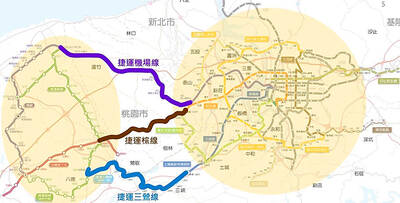More than 96 percent of Taiwanese Internet users said they had used social networking sites within the past two weeks, with Facebook remaining the most popular outlet for people to interact online, according to a survey.
In a report released yesterday, the Market Intelligence & Consulting Institute (MIC) of the Institute for Information Industry said it found that YouTube was the most popular multimedia sharing platform, while local Web sites Mobile01 and PTT were the most frequented online discussion forums.
Of the Internet users in the survey, 96.2 percent said they had used social media within the two weeks prior to the survey, while 54.7 percent reported using multimedia sharing platforms, 39.6 percent had used discussion boards, 28.9 percent had used blogs, 15.5 percent had used microblogging sites and 13.8 percent had used photo-sharing platforms.
Facebook was the most-used social networking site by a huge margin, with 95.8 percent of respondents having used it, with Google+ claiming a distant second at 24.7 percent.
The third, fourth and fifth places went to Taiwanese sites Pixnet (20.7 percent), Xuite (12.7 percent) and Plurk (8 percent).
Following YouTube (96.5 percent), the most popular sharing sites were Chinese site Tudou (23.6 percent) and PPStream (20.3 percent), Yahoo Screen/Movies (19.5 percent) and Xuite Vlog (17.7 percent).
Mobile01 (51.4 percent) was named the most popular forum, with PTT (51.2 percent) close behind, followed by Yahoo Knowledge (46.2 percent), Eyny (35.5 percent) and CK101 (23.4 percent).
The survey found that social networking is a platform for respondents to keep in contact with real-life friends (73 percent), family members (60.3 percent), people from work (42.4 percent), friends who they have not seen in a long time (35.4 percent) and friends they know only online (27.9 percent).
The online survey was conducted in March and collected 2,187 samples with a margin of error of 2.1 percent.

The Executive Yuan yesterday approved a southwestern extension of the Sanying MRT Line from New Taipei to Bade District (八德) in Taoyuan, with a goal of starting construction by late 2026. The 4.03-kilometer extension, featuring three new stations, will run from the current terminus at Yingtao Fude Station (LB12) in New Taipei City to Dannan Station (LB14), where it will connect with Taoyuan’s Green Line, New Taipei City Metro Corp said in a statement. This extension will follow the completion of core Sanying Line, a 14.29-kilometer medium-capacity system linking Tucheng (土城), Sansia (三峽)

CARGO LOSS: About 50 containers at the stern of the ‘Ever Lunar’ cargo ship went overboard, prompting the temporary closure of the port and disrupting operations Evergreen Marine Corp, Taiwan’s largest container shipper, yesterday said that all crew members aboard the Ever Lunar (長月) were safe after dozens of containers fell overboard off the coast of Peru the previous day. The incident occurred at 9:40am on Friday as the Ever Lunar was anchored and waiting to enter the Port of Callao when it suddenly experienced severe rolling, Evergreen said in a statement. The rolling, which caused the containers to fall, might have been caused by factors including a tsunami triggered by an earthquake in Russia, poor winter sea conditions in South America or a sudden influx of waves,

The Ministry of Culture yesterday officially launched the “We TAIWAN” cultural program on Osaka’s Nakanoshima sandbank, with the program’s mascot receiving overwhelming popularity. The cultural program, which runs from Aug. 2 to 20, was designed to partner with and capitalize on the 2025 World Expo that is being held in Osaka, Japan, from April 13 to Oct. 13, the ministry said. On the first day of the cultural program, its mascot, a green creature named “a-We,” proved to be extremely popular, as its merch was immediately in high demand. Long lines formed yesterday for the opening

The Taipei Summer Festival is to begin tomorrow at Dadaocheng Wharf (大稻埕), featuring four themed firework shows and five live music performances throughout the month, the Taipei Department of Information and Tourism said today. The festival in the city’s Datong District (大同) is to run until Aug. 30, holding firework displays on Wednesdays and the final Saturday of the event. The first show is scheduled for tomorrow, followed by Aug. 13, 20 and 30. To celebrate the 30th anniversary of Disney Pixar's movie Toy Story, the festival has partnered with Walt Disney Co (Taiwan) to host a special themed area on